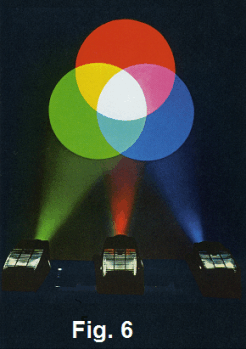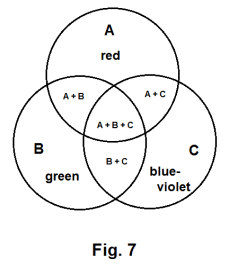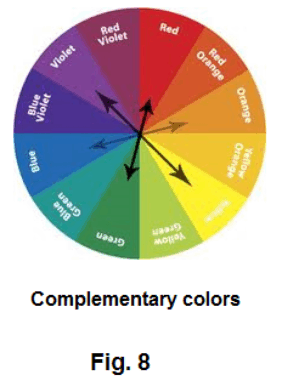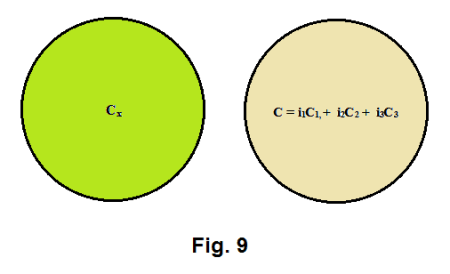
Website owner: James Miller
Color. The solar spectrum. Monochromatic and polychromatic light. Perception of color. Complementary colors. Mixing of pigments. Chromatic aberration.


The solar spectrum. A great historic advance in the understanding of the nature of light came through a series of experiments performed by Sir Isaac Newton from 1666 to1672. In these experiments Newton, in a darkened room, passed a narrow beam of sunlight from a small hole in a window shutter though a triangular glass prism. The light coming out of the prism was projected onto a wall 22 feet away. What appeared on the wall was a rainbow band of colors ranging from red to green to violet as shown in Fig. 1. Newton then placed a second prism behind the first, but in a reversed position as shown in Fig. 2, and found that the rays coming out of the second prism were reunited into a colorless beam of white light.

Newton performed another experiment. He cast a spectrum on a card that had a small hole cut out of it and placed a prism behind the hole as shown in Fig. 3. The hole allowed light of only a single color of the spectrum to pass through to the second prism. He wished to know if this light passing through the hole would be again expanded into a band of color. It was not. Green light, for example, coming through the hole was bent by the prism, but remained green.
At the time of Newton it was a common belief among researchers that color was a mixture of light and darkness, and that prisms colored light. Robert Hooke was a proponent of this theory of color. Newton’s experiments discredited that theory and showed that white light consists of a band of

colors. When a beam of sunlight is passed through a prism, the different colors of which light is composed are refracted at different angles and the different colors in the light separate out. See Fig. 4. The band of colors produced when sunlight is dispersed in this way by a prism is called the solar spectrum. This spreading of light out into its component colors is known as dispersion.
From the above we see that the index of refraction of a substance depends on the wavelength of the light used and for very accurate values of the index of refraction we need to use light of a particular wavelength and to specify that wavelength.
Color is a property of light waves that depends on the length of the light wave, where different wavelengths correspond to different colors. The wavelength λ of light is related to its frequency f by the formula
1) c = fλ
where c is the velocity of light. The wavelength of light may be expressed in different units:
1. Angstrom units (abbreviated A) where 1A = 10-10 meters
2. Microns (abbreviated μ) where 1μ = 10-6 meters
3. Millimicrons (abbreviated mμ) where 1 mμ = 10–9 meters
Def. Monochromatic light. Light consisting of a single color i.e. light of one particular wavelength. One never finds light of a single wavelength so monochromatic light is light of a very narrow band of wavelengths.
Def. Polychromatic light. Light consisting of more than one color i.e. several colors. Polychromatic light stands in contradistinction to monochromatic light.

How does one produce monochromatic light? One can produce monochromatic light by using light filters. See Fig. 5. These consist of coated or dyed glass or plastic that allow only certain wavelengths to pass through, blocking the rest. There are three types of light filters: longpass, shortpass and bandpass. Longpass filters allow only wavelengths above a specified wavelength to pass, blocking the rest; shortpass filters allow only wavelengths below a specified wavelength to pass; bandpass filters allow only wavelengths between two specified wavelengths to pass.

Perception of color. We now wish to make a very important point that needs to be understood. If we see some object that appears to be, say green, this does not mean that the light reaching our eye is monochromatic light of the green wavelength. Most likely it is polychromatic light containing a mixture of colors of various wavelengths and different intensities that our eye-brain system is seeing as green. There is an infinity of combinations of wavelengths/intensities (i.e. combinations of different colors), that the eye-brain system sees as green. The same goes for all colors. Consider the following experiment: If, in the solar spectrum produced by a prism, we block out the red wavelengths and allow the rest of the wavelengths to pass through a second prism, the color of the light emerging from the second prism is blue-green – that is, it is seen by the eye as blue-green. It is actually all the wavelengths from orange through violet, of course, but the eye sees it as blue-green. Thus just because an object appears to be, say blue-green, doesn’t mean the light coming from it is blue-green light. The light coming from it could be some combination of wavelengths that the eye is seeing (or interpreting) as blue-green. Thus a ray of polychromatic light incident at some particular point on the eye’s retina is interpreted as some particular color, not a mixture of colors. How the eye-brain system works is probably unknown but by some means it will perceive some particular color at that point on the retina. How it picks and assigns a color is an interesting question.
Adding monochromatic colors. Using three projectors equipped with red, green and blue-violet light filters let us project on a white screen beams of red, green and blue-violet monochromatic light as shown in Fig. 6. In Fig. 7 we see a schematic diagram of Fig. 6. These two figures illustrate how monochromatic light adds. We see that

red + green = yellow-orange
red + blue-violet = magenta (purple)
green + blue-violet = cyan (blue-green)
red + green + blue-violet = white

This gives us some idea of how the eye-brain system sees simple combinations of monochromatic light.
Def. Complementary colors. Any two colors that combine to form white light are called complimentary.
In Fig. 7 we note that the complement of green is magenta [the intersection of green (B) and magenta (A + C) is white (A + B + C)]; the complement of red is cyan [the intersection of red (A) and cyan (B + C) is white (A + B + C)]; the complement of blue is yellow-orange [the intersection of blue (C) and yellow-orange (A + B) is white (A + B + C)]. So in general, the complement of one of the colors red, green and blue-violet is the color formed by adding the other two. In the color wheel of Fig. 8 opposite colors are complementary.
Color matching using three base colors. Let us now adjust the projectors shown in Fig. 6 so that the three projected circles coincide. Denote the color of the monochromatic light projected by Projector 1 by C1, the color of the monochromatic light projected by Projector 2 by C2, the color of the light projected by Projector 3 by C3. In Fig. 6, C1 = red, C2 = green, and C3 = blue. We want to consider C1, C2, and C3 as variables that can assume different color values. In addition, we wish to provide each of the three projectors with devices for controlling the amount of luminous flux that they emit (for example, by using a rheostat in connection with the projection lamp). Let i1, i2, and i3 represent the amount of luminous flux that projectors 1, 2, and 3 are respectively emitting and let i1C1, i2C2, and i3C3 be the colors that the projectors are projecting onto the screen at those particular values of i1, i2, and i3. Then for any particular set of values of i1, i2, and i3 the color that appears on the screen will be given by
C = i1C1, + i2C2 + i3C3

We now set up a fourth projector that projects some arbitrary color Cx on the screen and try to match color C to color Cx by adjusting the values of the variables of i1, i2, and i3. See Fig. 9. We find that given any set of base colors C1, C2, C3 there is a wide gamut of colors Cx that can be matched. However, there is no set of base colors C1, C2, C3 that can match all colors Cx. Even if we were to extend the number of base colors from 3 to any number n, there would still be some colors Cx for which a match could not be secured. Having said all this, it is a fact that the base colors red, green and blue-violet provide the best set of base colors in the sense that they give matches to the widest gamut of colors Cx. As a consequence, the colors red, green and blue-violet are often called the primary colors.
The mixing of pigments. If one adds, let us say, red and green pigments, one does not get the same color as he does if he adds red and green light. The mixing works differently, the mechanism is different. In mixing pigments, one must understand that each component pigment absorbs certain wavelengths and the resulting color of the mixture is determined by those wavelengths that are not absorbed i.e. by those that are reflected. In other words, each pigment in the mixture subtracts certain wavelengths from white light and the color of the mixture is determined by the wavelengths that remain.
The primary pigments. The primary pigments are cyan (blue-green), magenta (purple), and yellow-orange. They are the complements of the three primary colors.
Chromatic aberration in lenses. The index of refraction of a substance depends on wavelength and when polychromatic light passes through a lens, the different wavelengths in the light are refracted by different angles. Since violet light is bent more than the other colors, it is brought to a focus by a double convex lens at a point nearer the lens than the other colors. Red light is refracted the least and it is brought to a focus farther from the lens than the other colors. The result of this is that images formed by ordinary spherical lenses are always fringed with a rainbow ring of colors. This non-focusing of polychromatic light is called chromatic aberration.
Remedy for chromatic aberration. Chromatic aberration can be remedied by using a combination of lenses consisting of a double convex lens made of crown glass and a plano-concave lens made of flint glass. This type lens combination is called an achromatic lens.
References
Dull, Metcalfe, Brooks. Modern Physics
Sears, Zemansky. University Physics
Semat, Katz. Physics
Freeman. Physics Made Simple
Bennett. Physics (COS)
Jesus Christ and His Teachings
Way of enlightenment, wisdom, and understanding
America, a corrupt, depraved, shameless country
On integrity and the lack of it
The test of a person's Christianity is what he is
Ninety five percent of the problems that most people have come from personal foolishness
Liberalism, socialism and the modern welfare state
The desire to harm, a motivation for conduct
On Self-sufficient Country Living, Homesteading
Topically Arranged Proverbs, Precepts, Quotations. Common Sayings. Poor Richard's Almanac.
Theory on the Formation of Character
People are like radio tuners --- they pick out and listen to one wavelength and ignore the rest
Cause of Character Traits --- According to Aristotle
We are what we eat --- living under the discipline of a diet
Avoiding problems and trouble in life
Role of habit in formation of character
Personal attributes of the true Christian
What determines a person's character?
Love of God and love of virtue are closely united
Intellectual disparities among people and the power in good habits
Tools of Satan. Tactics and Tricks used by the Devil.
The Natural Way -- The Unnatural Way
Wisdom, Reason and Virtue are closely related
Knowledge is one thing, wisdom is another
My views on Christianity in America
The most important thing in life is understanding
We are all examples --- for good or for bad
Television --- spiritual poison
The Prime Mover that decides "What We Are"
Where do our outlooks, attitudes and values come from?
Sin is serious business. The punishment for it is real. Hell is real.
Self-imposed discipline and regimentation
Achieving happiness in life --- a matter of the right strategies
Self-control, self-restraint, self-discipline basic to so much in life